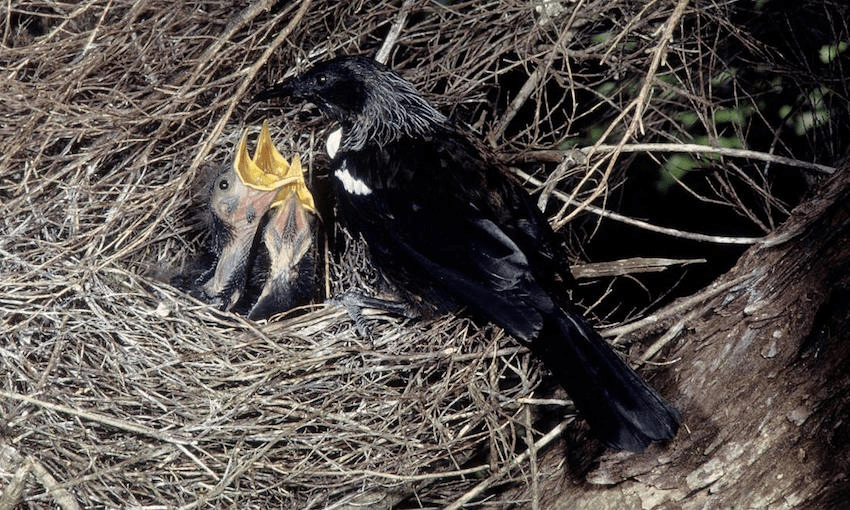Hakihea (December) brings clear skies, tui chicks and plenty of energy.
Learn more about the maramataka, the Māori lunar calendar, here.
Matiti Muramura is finally here, the third summer phase, indicating bright blue skies stretched across our shores. We look forward to golden days and bright, starry nights. Our tohu (signs) are the rising of Rehua (Antares) and the sound of the tūī bird. When the female tūī (teoteo) calls, the piipii tūī (chicks) have hatched!
The next phase is Matiti Kaiwai and tohu will start to appear this month as we transition. In Matiti Kaiwai, Rehua rises and the ground dries and opens showing cracks in the earth. The tohu our tūpuna used for this time was: ‘Te waru i Kataina e Rehua’, meaning the eighth month of the year, when the ground laughs as a result of Rehua.
Key maramataka dates (west coast)
7, 8 and 9 December – Mawharu, Atua, Ohua: Rehua star due to rise
10, 11 and 12 December – Oturu, Rakaunui and Rākau ma tohi: High energy days leading into festive season. These high energy days are around the full moon which is opposite to Whiro. Get all your preparation done now so you can relax on Christmas day – now is the time to do all the running around in preparation for the festivities!
15, 16 and 17 December – Korekore te whiwhia, Korekore te rawea and Korekore piri ki ngā tangaroa: These are low energy days like Whiro and Oike. It’s important to be prepared, organised and well rested during this time. Also drink more fluids!
18, 19 and 20 December – Tangaroa a mua, Tangaroa a roto and Tangaroa kiokio: Great fishing and planting time, get all your kaimoana now for Christmas. You are more likely to catch the big ones on these days.
25 December Christmas Day – Whiro: Christmas day this year on the west coast falls on Whiro. Other parts of the country may vary by one day, but all around the motu Christmas Day will be a relaxed, reflective day, which is perfect to spend quality time with whānau.
30 December to New Year’s Day – Tamatea phase (Tamatea a ngana, Tamatea a hotu and Tamatea a io): An unpredictable energy phase and considering the festive season it will bring mostly positive surprises. At the same time take it easy on the roads.
Reciprocity days (utunga)
4 December – Huna (give back to the ocean): A day to give back to Tangaroa, e.g. picking up rubbish and reusing or saving water.
14 December – Oike (give back to land): Give back to Papatūānuku (mother earth) or people.
21 December – Otane (give back to the ngahere): Acknowledging/giving to the forest/ngahere (bush), whenua (land), birds or animals.
28 December – Ouenuku (give back to Ranginui, the sky/heavens): A dedicated day to giving back to Ranginui (sky father) by elevating our thoughts. The intention is to enhance relationships with whānau, friends and community.
Tohu in Hakihea
Tohu will vary from coast to city to ngahere (bush area). The Rehua star however is a common tohu for many regions. Rehua is also known as Rerehu in Tainui. This bright star is not just a tohu in summer but also for the Māori New Year, on the opposite side of the year (Matariki is not the only tohu). Rehua rises in the east in December and sets in the west in June, triggering the New Year. When Rehua sets in the New Year, Pūanga rises.
Tohu o te rangi (signs in the sky)
Rehua the Antares star. She rises in the east around 8 December. In Hawaii the tohu is the Pohutukawa flower which is called Lehua. When the Rehua star rises the Lehua flower blooms. This maramataka knowledge was brought to Aotearoa over a thousand years ago by our tūpuna. Today these stories help keep our maramataka and connection across the Pacific alive.
Tohu o te moana (signs in the water)
Kahawai gather at the river mouths in late December in preparation to run in January.
Tohu o te whenua (signs on land)
Pōhutukawa and northern rātā will flower at the same time and Christmas plums start to ripen.
Please note: This is intended as a guide to help you learn about key dates in the maramataka and read the tohu (signs). Tohu will change from area to area and therefore while the dates above might be accurate for Auckland Manukau Harbour area, dates may vary for those in other rohe.
